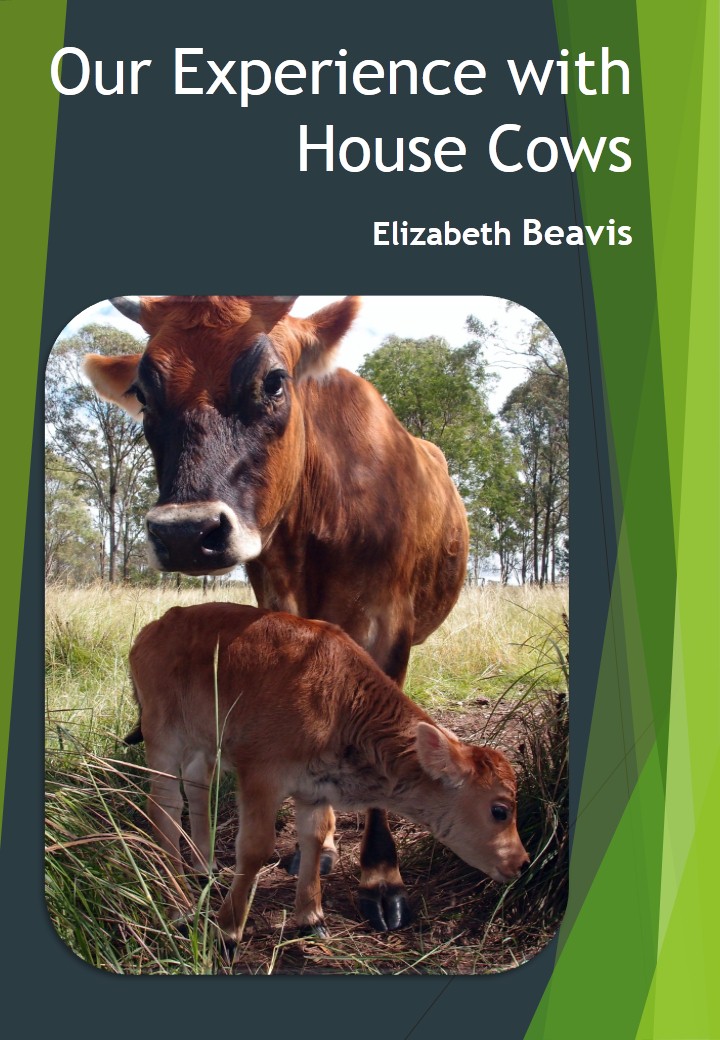Bottle feeding a calf
Getting a calf started on the bottle is not easy. At first they are scared and miss their mum, so they don't cooperate at all. When little Trevor first came home with us he was only a few weeks old. We struggled with him for days, my husband standing over him to hold his head still and me trying to get the teat in Trevor's mouth. Eventually he worked it out and we were greeted each morning at sunrise with hungry mooing as he paced up and down his pen waiting impatiently for his bottle. Those days when he wouldn't feed were very stressful though, we didn't know if he would die of hunger and we were seriously considering loading him back in the ute and taking him back to his mum! Molly was exactly the same, but after a few days, just like Trevor, she got hungry enough to work out what we were trying to do and then she was waiting for her bottle after milking morning and evening and finishes it with no trouble.
We use a Speedy-feeder that we bought when Trevor was being so difficult. It has different speed settings and a nice big handle. Its not really necessary, a teat on a soft-drink bottle is a cheaper option, but we were willing to try anything when we thought Trevor was going to die, so we spent money on a fancy bottle!
After a few weeks, when Molly was big enough, we started leaving her with Bella during the day and only separating them at night. We started feeding Molly calf pellets and grain in the afternoon and leading her into her pen with her bucket. Now she recognises her bucket of food and we can easily lead her anywhere.
You might also be interested in my series on getting started with homestead dairy
| Trevor working out the bottle after a few days - when he was hungry enough! |
After a few weeks, when Molly was big enough, we started leaving her with Bella during the day and only separating them at night. We started feeding Molly calf pellets and grain in the afternoon and leading her into her pen with her bucket. Now she recognises her bucket of food and we can easily lead her anywhere.
| Molly knows that grain comes in a bucket. |
Starting a young calf on grain is also difficult. When you start reading about the complicated processes that occur in the stomachs of ruminants, such as cattle, it can seem quite daunting! To put it simply, ruminants need bacteria in their stomachs to help them to digest grain and grass, but they don't have any of those bacteria when they're first born. They need to nibble on a bit of grain and grass so that they slowly build up some bacteria, but they can't have too much at first until the bacteria is established. This was very confusing with Trevor, as we had to try to give him the right amount and build up his system so that he could be weaned (at $100 for 20 kg, you don't want to buy any more powdered milk replacer than you have to!). With Molly having free access to milk and wandering around with Bella and nibbling on whatever Bella is eating, we have been able to let nature take its course. We probably won't wean Molly until Bella is ready for her next calf, so she shouldn't have any trouble with digestion.
Have you bottle fed a calf? Any tips for getting them started?
Interview with myself
Interview with Mark and Kate from Purple Pear Permaculture
Interview with Kim from the Little Black Cow
Interview with Rose Petal
Interview with Marie from Go Milk the Cow
Interview with Ohio Farmgirl
Interview with Mark and Kate from Purple Pear Permaculture
Interview with Kim from the Little Black Cow
Interview with Rose Petal
Interview with Marie from Go Milk the Cow
Interview with Ohio Farmgirl
Buy my ebook "Our Experience with House Cows" on Etsy, Lulu and Amazon, or email on eight.acres.liz at gmail.com to arrange delivery. More information on my house cow ebook blog.
Reviews of "Our Experience with House Cows"
Gavin from Little Green Cheese (and The Greening of Gavin)




















Leave a comment